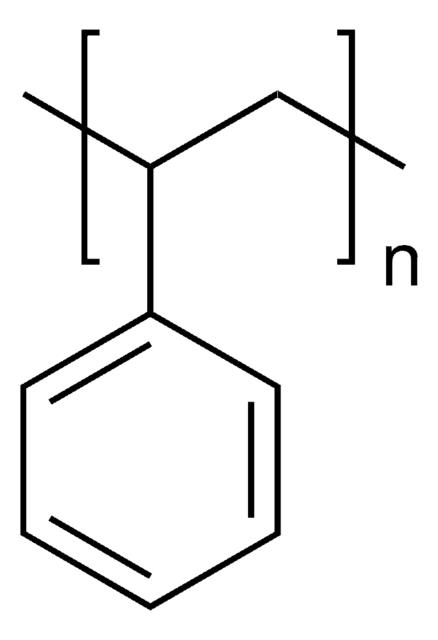All Photos(2)
About This Item
Linear Formula:
[CH2CH(C6H5)]n
CAS Number:
MDL number:
UNSPSC Code:
12162002
PubChem Substance ID:
NACRES:
NA.23
Recommended Products
form
beads or pellets
Quality Level
melt index
6.0-9.0 g/10 min (200°C/5kg)
mol wt
average Mw ~192,000
refractive index
n20/D 1.59
transition temp
softening point 107 °C (Vicat, ASTM D 1525)
SMILES string
c1(ccccc1)C=C
InChI
1S/C8H8/c1-2-8-6-4-3-5-7-8/h2-7H,1H2
InChI key
PPBRXRYQALVLMV-UHFFFAOYSA-N
Looking for similar products? Visit Product Comparison Guide
Related Categories
General description
Hard, clear moderately strong polymer, biologically inert, good dimensional stability. Susceptible to exterior (UV) degradation.
Application
Extrusion molded foamed packaging, dinnerware, bottles and toys. Injection molded packaging containers, toys and disposable cutlery.
Physical form
Thermoplastic amorphous polymer.
Storage Class Code
11 - Combustible Solids
WGK
WGK 3
Flash Point(F)
Not applicable
Flash Point(C)
Not applicable
Personal Protective Equipment
dust mask type N95 (US), Eyeshields, Gloves
Choose from one of the most recent versions:
Already Own This Product?
Find documentation for the products that you have recently purchased in the Document Library.
Customers Also Viewed
Dharneedar Ravichandran et al.
Molecules (Basel, Switzerland), 24(22) (2019-11-17)
Polystyrene (PS) polymers have broad applications in protective packaging for food shipping, containers, lids, bottles, trays, tumblers, disposable cutlery and the making of models. Currently, most PS products, such as foams, are not accepted for recycling due to a low
Marta Kocun et al.
ACS nano, 11(10), 10097-10105 (2017-09-28)
Tapping mode atomic force microscopy (AFM), also known as amplitude modulated (AM) or AC mode, is a proven, reliable, and gentle imaging mode with widespread applications. Over the several decades that tapping mode has been in use, quantification of tip-sample
Hui Xia et al.
Journal of colloid and interface science, 376(1), 322-326 (2012-03-27)
The aggregation kinetics of particles in dense polystyrene latex suspensions is studied by low-coherence fiber optic dynamic light scattering. Low-coherence fiber optic dynamic light scattering is used to measure the hydrodynamic radius of the aggregates. The aggregation kinetics data obtained
Harikrishnan Narayanan Unni et al.
Electrophoresis, 30(5), 732-741 (2009-03-05)
This study reports a theoretical and experimental study on the irreversible deposition of colloidal particles from electrokinetic microfluidic flow. The electrokinetic particle transport model presented in this study is based on the stochastic Langevin equation, incorporating the electrical, hydrodynamic, Derjaguin-Landau-Verwey-Overbeek
Liang Zhang et al.
Journal of colloid and interface science, 353(2), 557-561 (2010-10-30)
Reported are adsorption isotherms for guar and hydroxypropyl guar (HPG), with and without the presence of borate ions, onto surfactant free anionic polystyrene latex. Guar and HPG formed adsorbed monolayers on the hydrophobic latex. The presence of borate ions converted
Global Trade Item Number
| SKU | GTIN |
|---|---|
| 430102-1KG | 4061832107813 |
| 430102-3KG | 4061832107820 |
Our team of scientists has experience in all areas of research including Life Science, Material Science, Chemical Synthesis, Chromatography, Analytical and many others.
Contact Technical Service




